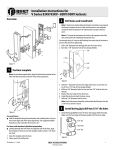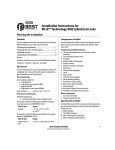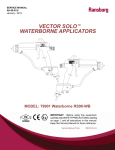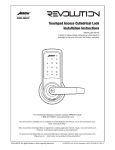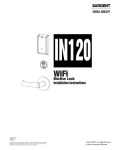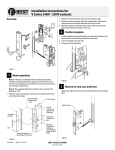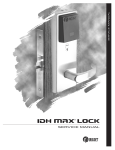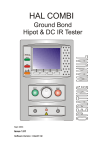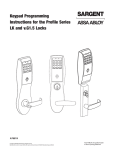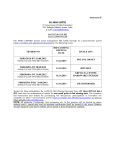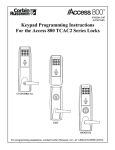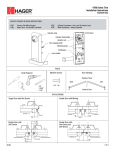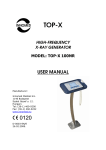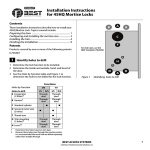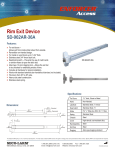Download Installation Instructions for V Series Cylindrical Locks
Transcript
Installation Instructions for V Series 83KV/93KV–85KV/95KV Locksets Overview 2 1 2 3 4 5 6 7 Figure 1 1 Drill holes and install latch Note 1: If the door is a fabricated hollow metal door, determine whether it is properly reinforced to support the lock. If the door reinforcement is not adequate, consult the door manufacturer for information on proper reinforcement. Note 2: To locate the centerpoint of a hole on the opposite side of the door, drill a pilot hole completely through the door. Note 3: For through-holes, it is best to drill halfway from each side of the door to prevent the door from splintering. Drill the 3/8“ diameter hole through the door for the motor wires. Bore the 2 1/8“ diameter hole (if not already bored). Drill the 1“ diameter hole into the edge of the door to meet the center of the 2 1/8“ diameter hole (if not already drilled). Drill the two 5/8“ diameter holes for the trim and one 7/8“ diameter hole for the wire harness. Mortise the edge of the door to accommodate the latch face. Install the latch and check that the door swings freely. Drill the 7/8“ diameter hole for the wires. Note: The latch tube prongs should be centered and should project into the 2 1/8“ diameter hole, as shown in Figure 7. Position template Note: On steel frame applications, align the horizontal centerline of the latch with the horizontal centerline of the strike preparation. 1 For uncut doors Fold the template along the perforation and carefully place it in position on the high side of the door edge bevel. The suggested height from the floor to the centerline of the lock is 38“. For doors with standard cylindrical preparation Looking through the hole from the opposite side of the door, align the template so that you see the template outline of the 2 1/8“ diameter hole. 2 Tape the template onto the door. 3 Center punch the drill points. 1“ diameter 5/8“ diameter 7/8“ diameter Latch face 3/8“ diameter 2 1/8“ diameter 5/8“ diameter Figure 3 3 Install boring jig and drill two 5/16“ diameter holes 1 Press the boring jig (KD303) onto the door, engaging it with the latch tube prongs. Make sure that the front edge of the jig is parallel with the door’s edge. C CL L CL 5/16“ diameter Latch tube prongs 5/16“ diameter Figure 2 Figure 4 T61852/Rev – 1852777 ER-7991-1 BEST ACCESS SYSTEMS Indianapolis, Indiana 1 2 Drill two 5/16“ diameter holes halfway into the door. 3 Turn the boring jig over and repeat steps 1 and 2 from the opposite side of the door. Note: Replace the boring jig after 10 door preparations. 4 Remove outside knob/ lever 1 Insert the control key into the core and rotate the key 15 degrees to the right. 2 Remove the core and throw member from the knob/lever. 3 Insert a flat blade screwdriver into the figure-eight hole and into the knob/lever keeper. 4 Press the screwdriver blade in the direction of the arrow in Figure 5. Note: You will not be able to remove the knob/lever if the screwdriver blade is inserted too far past the keeper. 5 Slide the knob/lever off the sleeve. Insert screwdriver blade here. Note 1: Make sure that the locking pin fully locks into the rose liner. Note 2: Locksets will fit doors 1 3/4“ to 2 1/4“ thick. (A spacer is available for 1 3/8“ doors.) See the enlarged view for the correct rose adjustment for these thicknesses. 6 Engage retractor in latch While feeding the motor wires through the 3/8“ hole to the inside of the door, insert the lock chassis into the hole. Caution: Be sure that the latch tube prongs engage the chassis frame and that the latch tailpiece engages the retractor. 2 Install the through-bolts through the liner and door in the top and bottom holes. 3 Tighten the liner onto the door with the through-bolts. 8 Install trim hole inserts, bushings, and hub washers 1 Insert the two trim hole inserts into the upper trim hole on each side of the door (see Figure 9). 2 Insert the two bushings into the wire hole on each side of the door (see Figure 9). 3 On each side of the door, slide a hub washer over the chassis sleeve so it rests on the hub. Enlarged view Retractor Bushing Trim hole insert Latch tube prongs Latch tailpiece Chassis frame Chassis Knob/lever keeper Figure-eight core hole Bushing Figure 7 Trim hole insert Figure 5 7 5 Hub washer Adjust to door thickness 1 Determine the door’s thickness. 2 Pull the rose locking pin and rotate the outside rose liner until the proper groove on the through bolt stud lines up with the hub face. Install through-bolts and rose liner 1 Making sure that the motor wires come through the notch in the 2 1/8“ hole, align the holes in the liner with the holes prepared in the door. Caution: Make sure that there is clearance for the motor wire between the rose liner and the door. 1 3/4“ 2“ 2 1/4“ Grooves on through-bolt stud Hub washer Figure 9 Hub Inside liner Hub face Through-bolt Pull rose locking pin to rotate rose. Figure 6 Sleeve Inside liner Figure 8 T61852/Rev – 1852777 ER-7991-1 BEST ACCESS SYSTEMS Indianapolis, Indiana 2 9 Make wire connections 1 Feed the outside wire harness connector through the top wire hole (see Figure 10). Wire hole Outside wire harness 10 12 Secure the trim 1 Pull the excess outside wire harness back through to the outside trim. 2 Position the inside and outside trim onto the door. 3 Making sure that the trim does not pinch the wires, secure the trim to the door — but do not tighten — with the combination mounting screw at the top mounting hole and with the standard screw at the bottom mounting hole. Install battery compartment door 1 Insert the tabs of the battery compartment door into its mating slots and swing the door closed. 2 Secure the battery compartment door with the security screw. Tighten firmly. Combination mounting screw Figure 10 2 Temporarily rest the trim on the door by inserting the trim studs into the stud holes. 3 From the inside of the door, connect the motor connector to the mating connector from the circuit board (see Figure 11). Note: It is possible to plug the battery pack into the motor connector and the motor wire into the battery connector. To avoid this, connect only the connectors with matching wire colors. 4 Making sure that the connector is properly aligned, connect the outside wire harness connector to the lower-right circuit board connector in the inside trim. Press firmly on the connector until it is fully seated. Wire harness Wire harness mating connector Security screw Tabs Standard mounting screw 13 Figure 12 11 Figure 14 Connect battery pack 1 Connect the battery pack to the connector hanging inside the battery compartment. 2 Insert the battery pack into the battery compartment so that the foam will face the battery door. Install inside and outside knobs/levers 1 For the inside and outside levers With the lever pointing toward the hinges, push firmly on the lever until it is seated. For the inside and outside knobs Push firmly on the knob until it is seated. 2 Tighten the trim mounting screws (see Figure 12). 3 Turn the knobs/levers to check that they operate smoothly. Battery pack Mating connector Motor connector Figure 11 Figure 13 Figure 15 T61852/Rev – 1852777 ER-7991-1 BEST ACCESS SYSTEMS Indianapolis, Indiana 3 14 Install strike plate Caution: The deadlocking plunger of the latchbolt must make contact with the strike plate, as shown in Figure 16. The plunger deadlocks the latchbolt and prevents someone from forcing the latch open when the door is closed. Deadlocking plunger 3 Insert the core and throw member into the knob or lever with the control key. 4 Rotate the control key 15 degrees to the left and withdraw the key. Note: Be sure to insert the correct throw member into the core: six-pin cores require the number “6” throw member; seven-pin cores require the number “7” throw member. Caution: The control key can be used to remove cores and access doors. Provide adequate security for the control key. Strike plate For proximity card electronic locks 1 Place the temporary operator card in front of the proximity reader (see Figure 21). The green light flashes and the locking mechanism unlocks B E S T Figure 16 For keypad electronic locks 1 Enter the temporary operator PIN 99998 on the keypad. 2 Press ✽. The green light flashes and the locking mechanism unlocks. 3 Turn the lever or knob and open the door. 4 Insert and turn the key to unlatch the door. 1 In alignment with the center of the latchbolt, mortise the door jamb to accommodate the strike box and strike plate. 2 Insert the strike box and secure the strike with the two screws provided. 16 Test lock To test the lock for proper operation, use the temporary operator card or personal identification number (PIN) that came with the lock. This card or PIN is for temporary use only and once permanent cards or PINs have been programmed for the lock, you should delete the temporary cards or PINs. These temporary operator cards and PINs will only work on factory default V Series locks. For details on programming the lock for access control, refer to the V Series Intelligent Programming Software User Manual or the V Series Handheld Terminal User Manual. One-half door thickness Door stop Door frame Figure 17 15 Figure 19 Install core and throw member 1 Install the blocking plate onto the throw member. Caution: You must use the blocking plate to prevent unauthorized access. For magnetic stripe card electronic locks 1 With the temporary operating instructions facing toward you, insert and remove the temporary operator card (see Figure 20). The green light flashes and the locking mechanism unlocks. 2 Turn the lever or knob and open the door. 3 Insert and turn the key to unlatch the door. Figure 21 2 Turn the lever or knob and open the door. 3 Insert and turn the key to unlatch the door. If the mechanism doesn’t unlock, refer to the following table. LEDs Sounder Access You should… 1 long tone Denied Use the token at a moderate speed. Green stays on Denied Use the temporary operator token, not the temporary communication token. Green flashes Denied Connect the motor wires. Denied Connect the battery and connect the outside wire harness. Blocking plate Throw member Figure 18 2 Insert the control key into the core and rotate the key 15 degrees to the right. T61852/Rev – 1852777 ER-7991-1 Figure 20 BEST ACCESS SYSTEMS Indianapolis, Indiana 4




